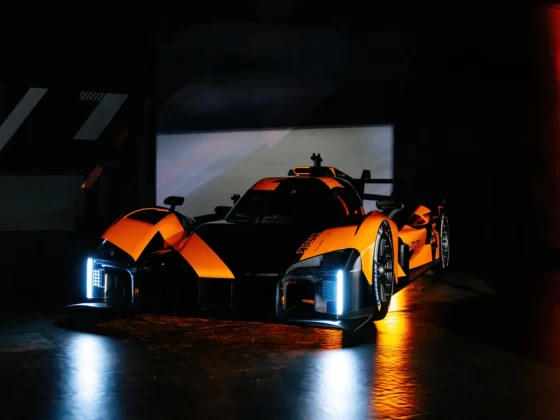“To have the opportunity to design an entirely new car from Bizzarrini is a privilege,” says Giorgetto Giugiaro, the legendary Italian designer and co-founder of Italdesign. “Our two names are united in nearly six decades of history and a series of now iconic designs.”
The “entirely new car ” Giorgetto has designed is the Giotto, a limited-run super sports car by the Bizzarrini automotive brand. Named in honour of the brand’s initial founder – the celebrated Italian automotive engineer and professor Giotto Bizzarrini – Giotto is the second model to emerge from its paddocks.
The first being the 5300 GT Corsa Revival launched in 2022. This 24-unit limited-edition racer is a revival of the Bizzarrini 5300 GT Strada, produced between 1965-1968. The 5300 GT Strada was styled by none other than Giorgetto Giugiaro, while he was working at Bertone.

Giotto Bizzarrini, the man who brought the 5300 GT Strada to life, hails from provincial Tuscany. He joined Alfa Romeo as a test driver in the 1950s and quickly earned a reputation as a genius engineer and test driver. This led to him being headhunted by Ferrari in 1957, and was pivotal in the development of the iconic Ferrari 250 GTO and the 250-based Drogo ‘bread van’ racer, among others.
In 1961, he co-founded Automobili Turismo e Sport (ATS) with other Ferrari engineers, and the following year, he founded the engineering firm Società Autostar (SA). One of SA’s clients was Lamborghini, for whom he helped develop its famed V12 engine. This engine was first used on Lamborghini’s debut model, the 350 GT, and various derivatives of this power unit was used until 2010.
In 1964, Giotto Bizzarrini founded Bizzarrini SpA, which was operational until 1969. During that time the company produced several models either co-branded with Iso or standalone. The most well-known example of the latter is the 5300 GT Strada. After Bizzarrini SpA folded, Giotto Bizzarrini worked as a consultant for several automotive brands before taking up a teaching position at Rome University.

Now, Giorgetto has been tasked with designing an all-new car to honour the legacy of Giotto Bizzarrini. He was the natural choice to establish the design language of an all-new Bizzarrini model given that he had designed the Bizzarrini 5300 GT. However, Giotto is not a solo project for Giorgetto. He has enlisted the services of his son Fabrizio to assist him.
“With the Giotto, we honour the past but we focus wholly on the future,” declares Giorgetto. “Designed for purpose, and incorporating active aerodynamic technologies, we have created something that is both recognisably Bizzarrini and totally relevant for an entirely new era of this cherished Italian brand.”
Giotto sports an intricately sculpted carbon fibre body with classic low-slung supercar proportions, a core design element of a Bizzarrini car. The prominent dual bonnet-mounted vents of the original Bizzarrinis have evolved into a new frontal visual character for the Giotto, and incorporate ultra-slimline LED headlights. As the lines slope down towards the centre of the bonnet, they cradle a prominent centre-mounted Bizzarrini badge, just as it was framed on the 5300 GT.

In profile, the Giotto reimagines the 5300GT’s triangular B-pillar and a rear windscreen that wraps so far around the rear it almost seems to cascade onto the wheel arches. Rear-mid-engined, rather than front-mid-engined like the 5300 GT, the Giotto has a predatorial forward stance. The tail gently tapers and curves away gracefully, creating an aerodynamic teardrop shape.
Given Giotto Bizzarrini’s connection to the Lamborghini V12, the powertrain of choice is reported to be a naturally aspirated V12 engine. it will be exclusively tuned to meet “Bizzarrini-specific performance, drivability, emissions compliance and emotional targets.” The V12 will be paired with an eight-speed dual-clutch transmission.
Development of the powertrain and all engineering aspects of the Giotto will be overseen by the newly appointed CTO, Chris Porritt. He has led engineering divisions at Aston Martin, Tesla and Rimac. “We have a very clear vision for the Giotto, defined ultimately by how it makes a driver feel,” says Porritt.
He adds: “Bizzarrini is a brand built on genius and passion, established by a polymath with world-class talents as a designer, engineer and test driver. We now very deliberately and authentically recreate Giotto’s vision, choosing not to chase acceleration times or lap records, but to develop a car that appeals to those experienced drivers seeking purity, authenticity and rarity. This is vocal and emotive, it’s mechanical and it’s tactile. But it’s also incredibly practical and luxurious, delivered with the personality and emotion of a bespoke Italian brand.”

As the Giotto unveiling gains momentum, the brand is busy welcoming new personnel. In addition to the new CTO, the brand also welcomes a new CEO, Ian Fenton. He brings 30 years of experience in the automotive industry, including senior or director roles in Ford of Europe, Ford Motor China, Jaguar Land Rover, Aston Martin Lagonda and Aston Martin Works.
The rebirth of the Bizzarrini brand occurred in 2020 as a subsidiary of the Pegasus Automotive Group – an international company representing some of the world’s leading luxury automotive and retail brands with operations in London, Geneva, Kuwait, Abu Dhabi and Dubai, USA, and the Far East. The Group’s Sports Classics subsidiary provides classic car buying, servicing, restoration, and consultancy services. Pegasus also manages its UAE-based Pegasus Prestige Service Center, which caters to luxury vehicles.
Commenting on the Giotto project, Dr Saeed Dana, President and Chairman of the Pegasus Automotive Group Board, said: “Giotto stands as a symbol of our commitment to providing the best vehicles to a select few. Whether it’s through our attention to detail or our use of premium materials, Bizzarrini is dedicated to being at the forefront of the luxury automotive industry.”
Testing of the Giotto is scheduled to begin in 2024. The company has announced that it will be releasing technical details throughout 2023.









